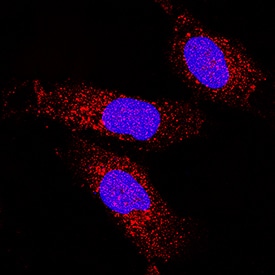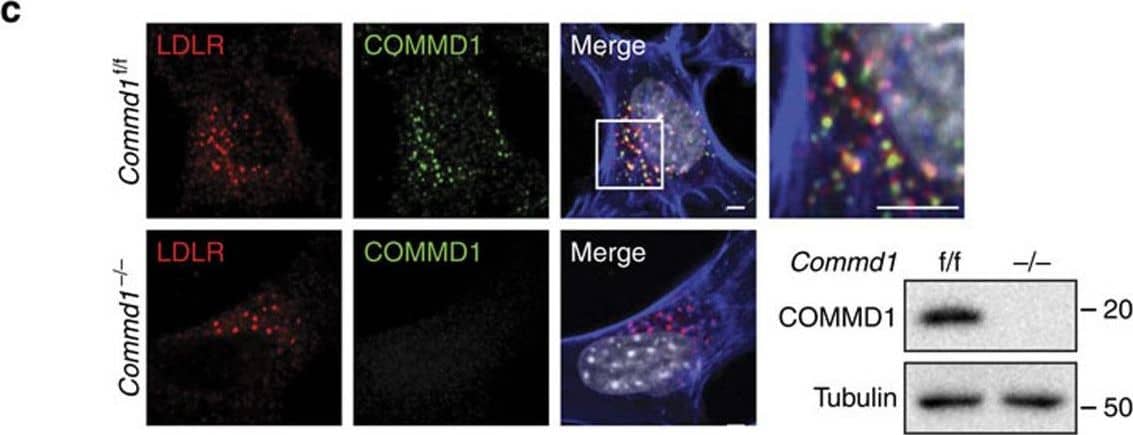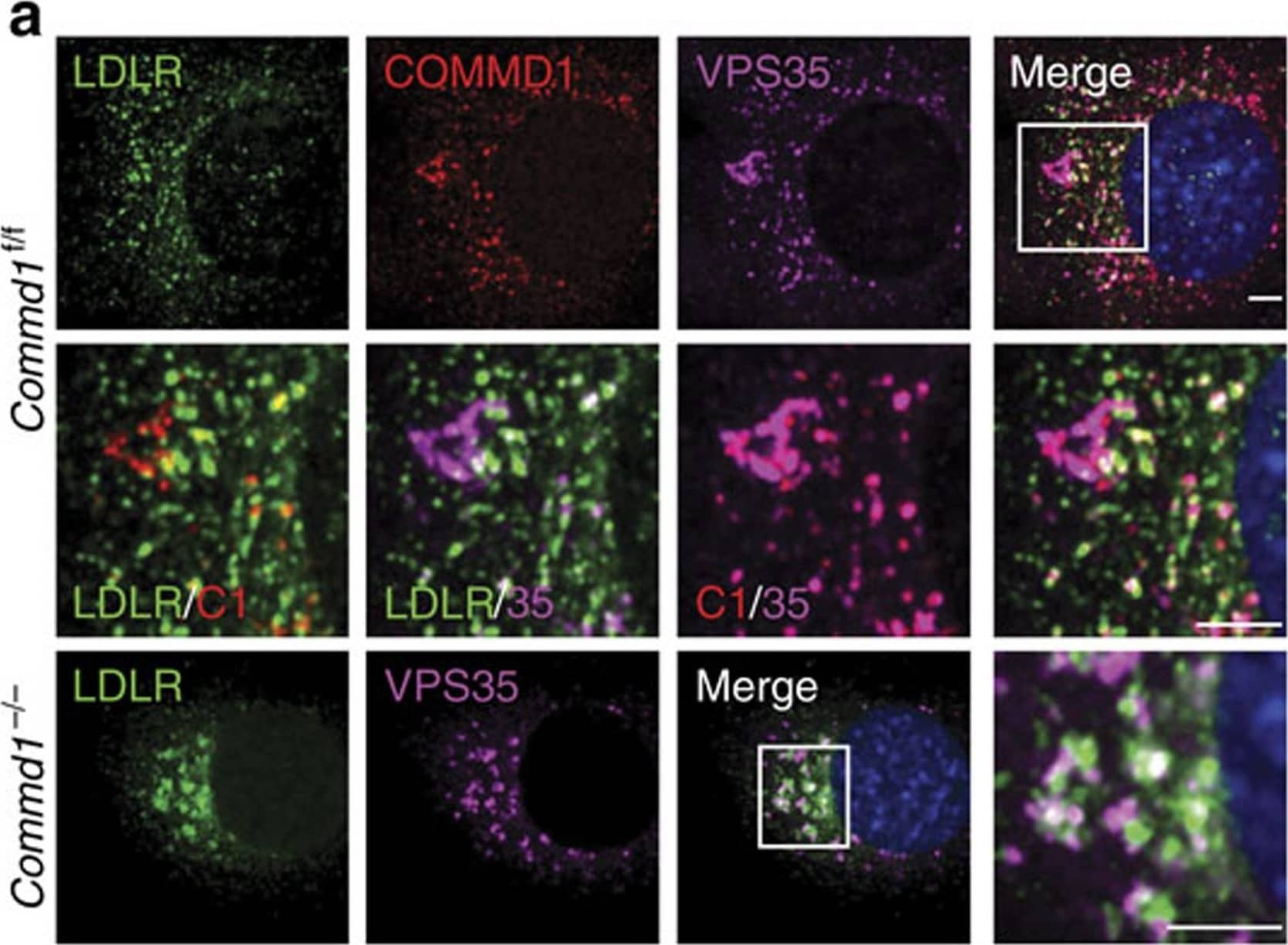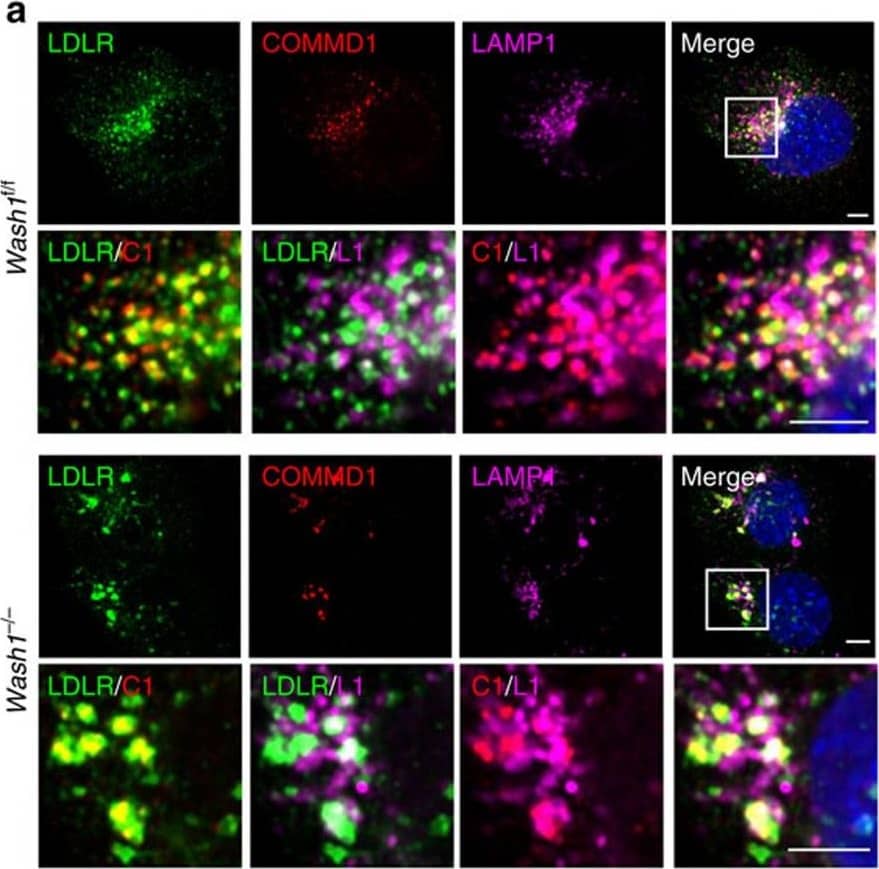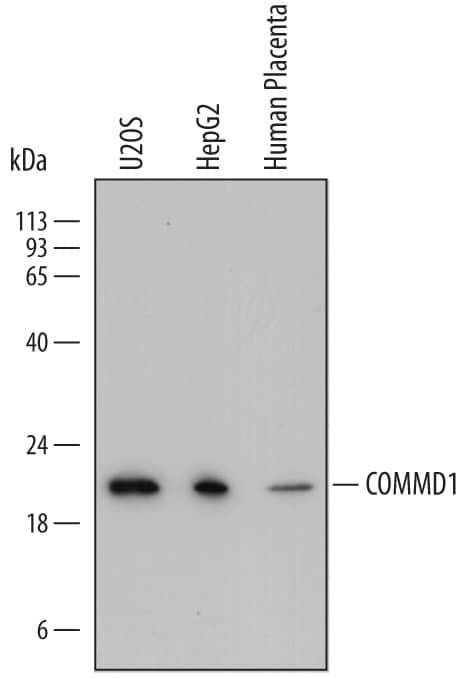Human COMMD1 Antibody
R&D Systems, part of Bio-Techne | Catalog # MAB7526

Key Product Details
Validated by
Biological Validation
Species Reactivity
Validated:
Human
Cited:
Human, Mouse
Applications
Validated:
Immunocytochemistry, Western Blot
Cited:
Immunocytochemistry, Immunoprecipitation
Label
Unconjugated
Antibody Source
Monoclonal Mouse IgG2B Clone # 762203
Product Specifications
Immunogen
E. coli-derived recombinant human COMMD1
Ser37-Ser135
Accession # Q8N668
Ser37-Ser135
Accession # Q8N668
Specificity
Detects human COMMD1 in direct ELISAs.
In direct ELISAs, no cross-reactivity
with recombinant human (rh) Attractin or rhCaspr1 is observed.
Clonality
Monoclonal
Host
Mouse
Isotype
IgG2B
Scientific Data Images for Human COMMD1 Antibody
Detection of Human COMMD1 by Western Blot.
Western blot shows lysates of U2OS human osteosarcoma cell line, HepG2 human hepatocellular carcinoma cell line, and human placenta tissue. PVDF membrane was probed with 0.2 µg/mL of Mouse Anti-Human COMMD1 Monoclonal Antibody (Catalog # MAB7526) followed by HRP-conjugated Anti-Mouse IgG Secondary Antibody (Catalog # HAF018). A specific band was detected for COMMD1 at approximately 20 kDa (as indicated). This experiment was conducted under reducing conditions and using Immunoblot Buffer Group 1.COMMD1 in U2OS Human Cell Line.
COMMD1 was detected in immersion fixed U2OS human osteosarcoma cell line using Mouse Anti-Human COMMD1 Monoclonal Antibody (Catalog # MAB7526) at 8 µg/mL for 3 hours at room temperature. Cells were stained using the NorthernLights™ 557-conjugated Anti-Mouse IgG Secondary Antibody (red; Catalog # NL007) and counterstained with DAPI (blue). Specific staining was localized to cytoplasm and nuclei. View our protocol for Fluorescent ICC Staining of Cells on Coverslips.Detection of Mouse COMMD1 by Immunocytochemistry/Immunofluorescence
LDLR associates with COMMD1 and the WASH complex.(a) Human embryonic kidney 293T (HEK293T) cells were transfected with constructs expressing Flag-LDLR with either COMMD1-GST or GST alone. Interaction with COMMD1 was detected via pull-down assay using glutathione sepharose beads. (b) HEK293T cells were transfected with Flag-LDLR vector, and interaction with endogenous COMMD1 was detected by immunoprecipitation with rabbit anti-Flag-antibody. (c) Colocalization of LDLR (red) and COMMD1 (green) in Commd1f/f MEFs examined by immunofluorescence staining. Representative images are shown; scale bar, 5μm. LDLR (red) and COMMD1 (green) was stained in COMMD1-deficient MEFs (Commd1−/−) and imaged by confocal fluorescence microscopy. COMMD1 levels in Commd1f/f and in Commd1−/− MEFs determined by immunoblot analysis. (d) Liver of a WT chow-fed mouse was homogenized and loaded on a continuous 10–40% sucrose gradient. Fractions were separated by ultracentrifugation and immunoblotted using antibodies against COMMD1, LDLR, WASH1, FAM21, VPS35 and CCDC22. The figure represents results of three independent experiments. (e) HEK293T cells were transfected with Ha-COMMD1 construct together with GST alone, GST-LDLRct (GST-tagged cytosolic domain of LDLR) or GST-LDLRct Y807A (GST-tagged mutated cytosolic domain of LDLR). Pull-down assay was performed to study the interaction between LDLRct and COMMD1. (f) Lysates of Flag-LDLR-transfected HEK293T cells were used for immunoprecipitation assays. Immunoprecipitates were washed, separated by SDS–polyacrylamide gel electrophoresis and immunoblotted as indicated. Image collected and cropped by CiteAb from the following publication (https://www.nature.com/articles/ncomms10961), licensed under a CC-BY license. Not internally tested by R&D Systems.Applications for Human COMMD1 Antibody
Application
Recommended Usage
Immunocytochemistry
8-25 µg/mL
Sample: Immersion fixed U2OS human osteosarcoma cell line
Sample: Immersion fixed U2OS human osteosarcoma cell line
Western Blot
0.2 µg/mL
Sample: U2OS human osteosarcoma cell line, HepG2 human hepatocellular carcinoma cell line, and human placenta tissue
Sample: U2OS human osteosarcoma cell line, HepG2 human hepatocellular carcinoma cell line, and human placenta tissue
Reviewed Applications
Read 1 review rated 5 using MAB7526 in the following applications:
Formulation, Preparation, and Storage
Purification
Protein A or G purified from hybridoma culture supernatant
Reconstitution
Sterile PBS to a final concentration of 0.5 mg/mL. For liquid material, refer to CoA for concentration.
Formulation
Lyophilized from a 0.2 μm filtered solution in PBS with Trehalose. *Small pack size (SP) is supplied either lyophilized or as a 0.2 µm filtered solution in PBS.
Shipping
Lyophilized product is shipped at ambient temperature. Liquid small pack size (-SP) is shipped with polar packs. Upon receipt, store immediately at the temperature recommended below.
Stability & Storage
Use a manual defrost freezer and avoid repeated freeze-thaw cycles.
- 12 months from date of receipt, -20 to -70 °C as supplied.
- 1 month, 2 to 8 °C under sterile conditions after reconstitution.
- 6 months, -20 to -70 °C under sterile conditions after reconstitution.
Background: COMMD1
Long Name
Copper Metabolism [MURR1] Domain Containing 1
Alternate Names
MURR1
Gene Symbol
COMMD1
UniProt
Additional COMMD1 Products
Product Documents for Human COMMD1 Antibody
Product Specific Notices for Human COMMD1 Antibody
For research use only
